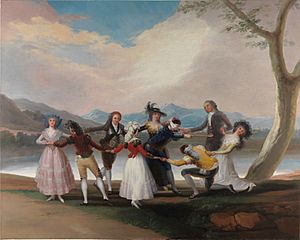Blind Man's Bluff (Goya) facts for kids
Quick facts for kids Blind Man's Bluff |
|
|---|---|
| Spanish: La gallina ciega | |
 |
|
| Artist | Francisco Goya |
| Year | 1789 |
| Medium | Oil on Canvas |
| Dimensions | 269 cm × 350 cm (106 in × 140 in) |
| Location | Museo del Prado, Madrid |
Blind Man's Bluff (Spanish: La gallina ciega) is a famous painting by the Spanish artist Francisco Goya. He created it in 1789. This artwork was designed to be a tapestry (a woven picture) for the Royal Palace of El Pardo in Spain.
The painting shows a group of young people playing a game called "blind man's bluff." One person in the middle is blindfolded. They hold a large spoon and try to tag the others who are dancing around them in a circle.
The children in the painting are dressed in fancy clothes. These were the clothes worn by rich families in Spain at the time. Some wear velvet jackets and hats with feathers. The painting shows a happy moment from everyday life. It uses soft colors like pink and yellow, which was typical of the Rococo art style.
Contents
What is Blind Man's Bluff?
Blind man's bluff is a classic game played by children around the world. One player is blindfolded. The other players quietly move around them. The blindfolded player tries to catch or identify another player. If they succeed, the caught player becomes the next one to be blindfolded.
How Goya Captured the Game
Goya's painting shows the excitement of the game. The blindfolded person reaches out, trying to find someone. The other players dance and try to avoid being caught. You can almost feel the fun and energy of the scene.
Who Was Francisco Goya?
Francisco Goya was a very important Spanish painter. He lived from 1746 to 1828. Goya painted many different kinds of art. These included portraits of kings and queens, scenes from everyday life, and even dark, imaginative works.
Goya's Tapestry Cartoons
Before he became famous for his other paintings, Goya created many "cartoons." These were large paintings used as models for tapestries. Tapestries are like huge woven pictures that decorate walls. Blind Man's Bluff is one of these special tapestry cartoons.
What is Rococo Art?
Blind Man's Bluff is an example of Goya's early work, which was in the Rococo style. Rococo art was popular in the 18th century. It is known for being light, playful, and decorative. Rococo paintings often show happy scenes, fancy clothes, and soft, bright colors. Goya later moved on to different art styles, but his Rococo works are still very charming.
Where Can You See This Painting?
Today, Blind Man's Bluff is kept in the Museo del Prado in Madrid, Spain. This museum has many famous artworks. It is a great place to see Goya's paintings up close.
See also
 In Spanish: La gallina ciega (Goya) para niños
In Spanish: La gallina ciega (Goya) para niños
- List of Francisco Goya's tapestry cartoons
- List of works by Francisco Goya

